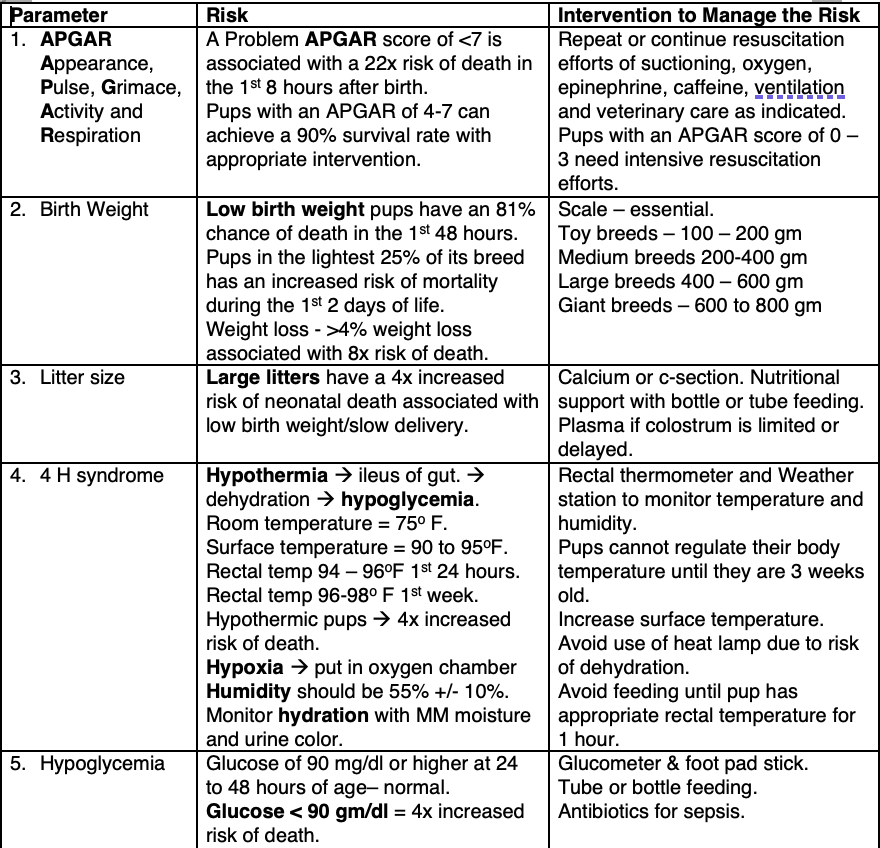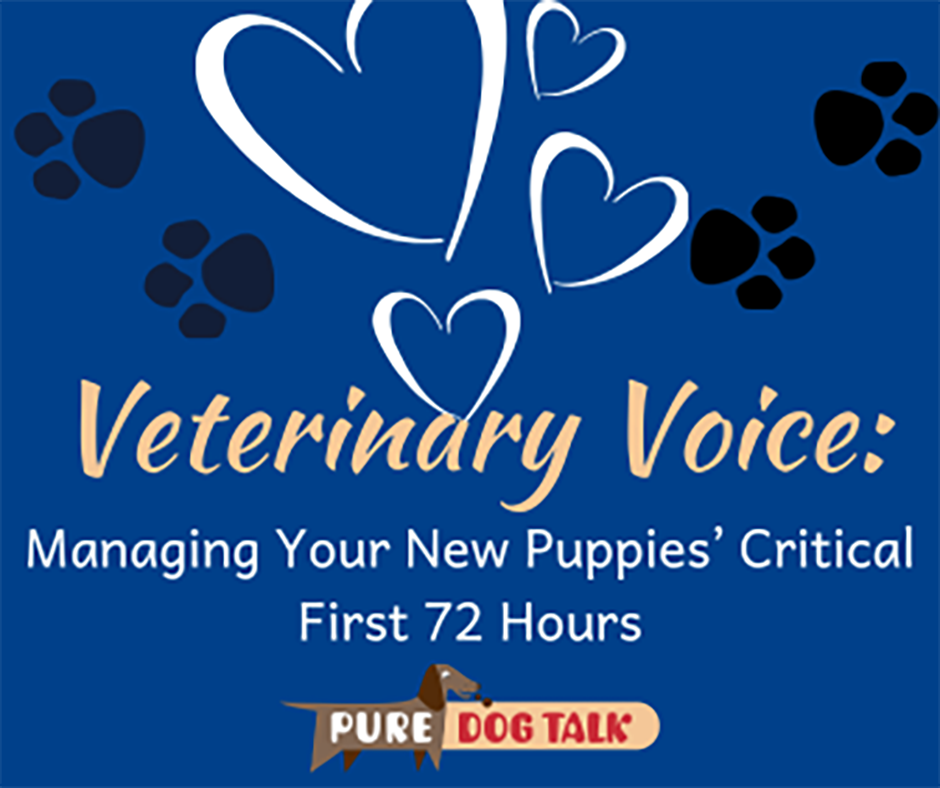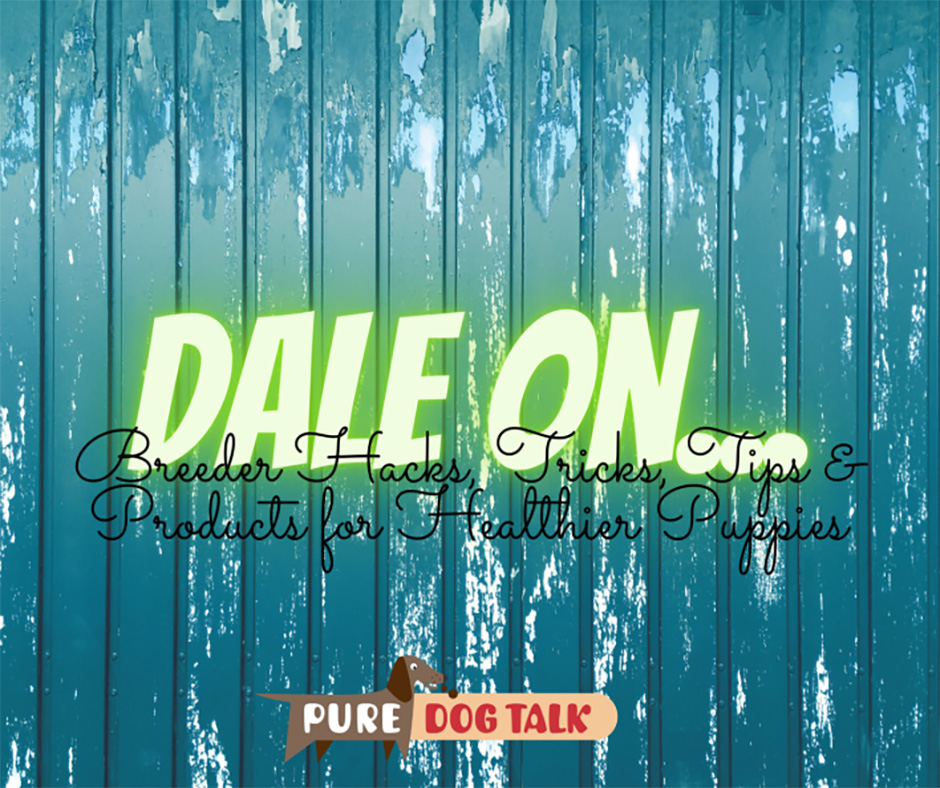623 – Managing Your New Puppies’ Critical First 72 Hours
Managing Your New Puppies’ Critical First 72 Hours
Dr. Marty Greer, DVM joins host Laura Reeves to discuss managing the critical first 72 hours with new puppies.
A recurring theme with breeders and new litters is the term “fading puppy.”
“(Fading puppy) is basically we’re just lumping a bunch of stuff together and calling it fading puppy,” Greer said, “because we don’t necessarily have a confirmed diagnosis. We may not have a diagnosis yet. We may never have a diagnosis, but it is not a diagnosis. It’s just a description of a puppy that fails to thrive. And I think that a better term is failure to thrive rather than fading puppy because it’s more clear that it’s not really a term of diagnostics.
“I think a lot of owners and veterinarians tend to kind of throw up their arms and say, ‘well, it’s a sick puppy. I don’t really know what to do with it.’
“Well, there’s a lot of things you can do. Diagnostically, you can do almost everything to a small puppy that you can do to a big dog. Now of course the bigger the puppy gets, the easier it is to do the diagnostics. But if you choose to pursue some of these diagnostics, it’s not that difficult. You can do an x -ray, you can do an ultrasound, you can do blood work. At the very least, do a glucose level.
“Worst case scenario, you lose a puppy. Don’t just put it in the freezer and walk away, take it to your veterinarian, ask them to either open it up for you or send it in for diagnostics.
“We’ve found things that are clearly one -offs. We’ve seen like the puppy doesn’t have an intestinal tract, a large intestine. Okay, that’s not gonna affect every puppy in the litter. But if you have herpes, if you have adenovirus, if you have distemper, if you have E. coli, if you have all these different kinds of diseases, the faster you can get a specific diagnosis and get a specific treatment put together, the better.”
Greer observed that puppies who fail to thrive may present as crying constantly or weak and not moving with the “swarm” of the litter. Dehydration and low body temperature are common and correctible issues that can knock a puppy down and even out in the first 72 hours.
Test hydration by monitoring urine color, Greer recommends, and be prepared to administer subcutaneous fluids if needed. Listen to the full episode as she walks listeners through this process and more.
619 – Puppy Evaluation System Developed by a Woman Ahead of Her Time
Puppy Evaluation System Developed by a Woman Ahead of Her Time

Virginia Apgar, who named the newborn evaluation system.
Dr. Marty Greer, DVM joins host Laura Reeves for their ongoing puppy discussion. This month Greer shares the story of Virginia Apgar, who named a now-famous newborn evaluation system after herself.
Apgar was a human anesthesiologist who graduated from medical school in the 1930s, Greer noted.
“She was the first female anesthesiologist admitted to the College of Anesthesiology back in an era where there were no women doctors. There were no women a lot of things. So she was truly remarkable, Greer said.
“In that era, a lot of babies were born to mothers that were sedated or anesthetized. And so (Apgar) developed a scoring system to analyze the babies and it has stuck for the last 70 years and it’s very impressive that it’s something that people talk about every day, still using the word APGAR. The acronym stands for: appearance, pulse, grimace, activity and respiration.”
The system was adapted for small animal veterinary use by a vet on staff at the University of Minnesota.

Parameters for APGAR scoring.
“The advantage of a numerical score,” Greer added “is that it gives you something that you can measure and compare litter to litter, puppy to puppy within the litter over the course of time. And we have some really good data from Neocare, which we talked about last time, about what the relationship with the APGAR score and the survival of these puppies will be. So it’s actually super cool that you can take all this information and turn it into something that you can use at home, you can use at your veterinary clinic, and that your veterinary clinic can help you with. So I would encourage people to learn to do APGAR scores. It’s not hard, it’s not mysterious. It’s really pretty straightforward on what to do with it.

Treatments for common whelping issues.
“The value of this is when you go home (from a csection, for example) and you have a puppy that had an APGAR score of a four and a puppy that had an APGAR score of a nine, that you know the puppy with the four needs a lot more attention to have the kind of survival rates that one would hope for. We always hope for a hundred percent (survival), but reality is 100% is probably not a realistic goal.
“Each of the five parameters, appearance, pulse, grimace, activity and respirations gets a score of a zero, one, or a two. So collectively, if you get twos on all five of your items, you have a score of a ten.
“It’s really simple to do. It doesn’t require high level assessment and like I said, a lot of us probably are intuitively already doing this. When you have puppy born, if it’s fish breathing and gasping and gaping, that’s not good. But, if it’s got nice pink color and it’s wailing and it’s crying and it’s wiggling and it’s pink and it’s all those things, you know that you’ve got a puppy that’s in pretty good shape. But it’s just nice to be able to give it a more numerical sign because that gives you data to work with.
“The average puppy is gonna be seven and up. It does give you a numerical score. The value of this is knowing that from the Neocare information, that’s from the University at the Toulouse -France Veterinary School, the puppies with an APGAR score of less than seven have a 22-fold increased risk of death in the first eight hours after they’re born.
“And they also know that puppies with APGAR scores between a four and a seven can achieve a 90 percent survival rate with the appropriate interventions. So, what does that mean? That means you suction them, you put them in oxygen, you make sure that they’re staying warm. You’re doing all those things that you already have been trained to do to help with puppy resuscitation so that they’re not just you know laying in the whelping box kind of hoping that they do okay.”
Greer’s seminal book “Canine Reproduction and Neonatology” is available HERE.
614 – Neonates: Hypoxia, Hypothermia, Hydration, Hypoglycemia
614 – Neonates: Hypoxia, Hypothermia, Hydration, Hypoglycemia
Dr. Marty Greer DVM joins host Laura Reeves to talk about the four H’s that constitute critical care of neonates: Hypoxia, Hypothermia, Hydration, Hypoglycemia.
“The four H’s are hypoxia which is oxygen,” Greer said. “Hypothermia which is temperature, hypoglycemia which is glucose and hydration which of course is hydration or dehydration. So we’ve got those four parameters and basing the rest of the discussion on that, we can get started with some pretty important things that you can do at home to measure, to manage. It doesn’t do you any good if you can’t manage it. But collecting the data doesn’t do you any good unless you use the data.
Greer notes there is currently no good way to measure blood oxygen levels in puppies at home, but that physical indications will give you an accurate starting place.
“You can look at puppies and say, are they nice and pink,” Greer notes. “Do they have a curled pink tongue? Or is their tongue kind of grayish, blueish, a little bit flat? So curled pink tongue means you keep working even at one minute, five minutes of age, curled pink tongue with that curl to the edges, you keep going. If it’s gray and flaccid and you’ve got other puppies that need your help, set that one off to the side, keep moving.”
Greer recommends breeders consider investing in an incubator and oxygen concentrator. She advocates for the Puppy Warmer system in particular.
Well-hydrated puppies will have very pale yellow urine when stimulated with a clean cotton ball or tissue, Greer observes.
“For me, hypoxia is first,” Greer said. “For me temperature is second and then hydration is third. That’s my particular order. Hydration is very important but temperature in the immediate birth period, in that first hour after birth. Puppies come out wet… They come out without any oxygen in them, other than what they got from their mom. So, they’ve got to start breathing immediately, and they’ve got to stay warm.
“And so you want to get them born into enough absorbent material, like warm towels, that you can very quickly get the puppies dried off. Again, the incubator that Puppy Warmer has is a great place to put them for drying.
“I like heat sources under the puppies, under the bitch and under the puppies. I don’t like the ones that come from above. The ones from above, I have concerns about dehydrating the puppies. I have concerns about the bitch getting too warm and not wanting to stay with her puppies. I’m concerned (about fires) started with heat lamps. So, I’m really not a fan of the overhead heating.
This is the first in a planned series of episodes about neonates, their care and deep dives into the first hours of a newborn puppy’s life. Listen in for more today and BOLO the first Monday of every month for more from Dr. Greer.
425 – Breeder Hacks, Tricks, Tips & Products for Healthier Puppies
Breeder Hacks, Tricks, Tips & Products for Healthier Puppies
Dale Martenson, renowned breeder of Touche Japanese Chin, joins host Laura Reeves to talk about some of our favorite hacks, some of our favorite products, some of our favorite things as dog breeders that don’t necessarily make it into the textbooks.
LISTEN to the episode for more details, by clicking the triangle arrow above.
Milk Balloons
“Litters of puppies, if we were going to put it in the hands of Mother Nature,” Martenson noted, “it would often be more like sea turtles … a certain percentage of them were meant to make it to the water and a certain percentage are not. As breeders, we want to tip the scales. We can add some supportive care, just to give those little turtles a boost to the water, to make it to a healthy adulthood…”
Martenson uses surgical gloves as an alternative method of supplemental feeding. Tube feeding can be difficult and even dangerous if not done properly. Plus, the actual process of suckling is important to the puppies’ digestion and development.
Heat from Down Under
Martenson shares methods for warming puppies while offering the bitch a cooler location in the whelping box, the dangers of heat lamps in general and the importance of providing a heat source *under* the puppies.
Do the Hoky Poky
Flooring for puppies in the whelping box is critical. A number of studies indicate that puppies whose feet slip while nursing or navigating the box are more likely to develop hip dysplasia. Martenson recommends small carpet remnants for toy breeds. We agreed that large, rubber backed washable fleece pads are a better choice for larger breed dogs.
Pumpkin Powder to the Rescue
Only dog people are as obsessed with poopy. The product Martenson recommends helps pups transition to new water, new schedule, new environment, possibly new food with no intestinal upset.
Eat up!
“ENTYCE is a fantastic appetite builder. So say your female isn’t wanting to eat and she’s 50 days, she’s trying to have pregnancy toxemia on you. Then you’re looking at hand feeding, syringe feeding, whatever kind of feeding we can do to make this happen. We’ve had fantastic results with that or traveling to the dog show and they’re not wanting to eat on the road. “
416 – Neonates: 6 Danger Signs to Watch for in Your New Litter
Neonates: 6 Danger Signs to Watch for in Your New Litter
Doctor Marty Greer joins Host Laura Reeves to talk about a topic that is near and dear to both of them. Troubleshooting guidelines for neonates and baby puppies.
“About the time you think you know it all is when somebody puts their thumb on you and says ha just kidding,” Greer said.
Greer’s four “Hs” for newborn puppies are:
- Hydration
- Hypoxia
- Hypothermia
- Hypoglycemia
“We need to start with making sure that the puppies get delivered quickly enough that they can get out of the birth canal, out of the sack, out of the C-section, whatever direction they come out, get the sac off the face, airway cleared and oxygen delivered as quickly as possible. That’s really critical to good health, good brain development and the whole rest of the cascade starts with that,” Greer said.
 “Hydration goes along with food,” Greer observed. “With a puppy, if they’re not nursing, they’re going to dehydrate and if they’re gonna not nurse, they’re going to have low blood sugar. These all intertwine.
“Hydration goes along with food,” Greer observed. “With a puppy, if they’re not nursing, they’re going to dehydrate and if they’re gonna not nurse, they’re going to have low blood sugar. These all intertwine.
“It’s really important that we keep the puppies nursing. If they’re not adequately nursing then the way to assess that is going to be if they’re not gaining weight and if their urine color isn’t a pale, pale yellow. Puppies should not have a dark colored urine after the first time that they urinate. So it should be pale yellow. The puppy should be gaining weight. You can’t really assess hydration on a puppy the way you do an adult dog or cat where you pinch the skin on the back of their neck and see if it seems tacky or sticky because puppies don’t have enough body fat to have that work the way it does another ages of animal. So we really have to look at urine color and weight gain.
Danger Signs
“You’ll see a puppy that seems weak, seems lethargic, seems listless. It may be really quiet or it may be crying. It just depends on the puppy and what stage in which they are.
 “I see a puppy off by itself, it may not be that the bitch pushed the puppy away. It may simply be that that puppy needs to be warmed, needs to be hydrated, need some oxygen. You do those three things — you feed it, you hydrate it, you warm it up, you get oxygen. And boom. All of a sudden, that puppy regains its strength and it starts to compete and be back with the rest of the group very quickly.
“I see a puppy off by itself, it may not be that the bitch pushed the puppy away. It may simply be that that puppy needs to be warmed, needs to be hydrated, need some oxygen. You do those three things — you feed it, you hydrate it, you warm it up, you get oxygen. And boom. All of a sudden, that puppy regains its strength and it starts to compete and be back with the rest of the group very quickly.
Listen to today’s episode for more tips from Dr. Greer.
For more information in previous episodes, check out some of these links.
https://puredogtalk.com/podcast/127canine-herpes-and-puppy-fatalitiesdr-jean-doddspure-dog-talk-2/
https://puredogtalk.com/podcast/14-dr-gayle-watkins-2-breeders-guide-to-neonatal-puppies-2/





